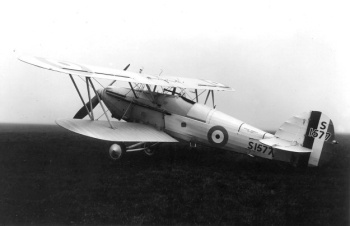Post by Diarist on Oct 18, 2015 17:42:02 GMT 1
The Hawker Nimrod is a British carrier-based single engine, single seat biplane fighter aircraft built in the early 1930s by Hawker Aircraft.
Design and development
In 1926 the Air Ministry specification N.21/6 was intended to produce a successor to the Fairey Flycatcher, then in its fourth year of Naval service. By the time it was replaced by the Nimrod in 1932, the Flycatcher had become so obsolete in terms of its speed that RAF officers who flew it often joked that a sprightly fly might actually give the aircraft a run for its money. None of the aircraft designed to this specification were selected for production after trials in 1928, but the radial engined Hawker Hoopoe, not actually designed to N.21/26, was considered promising enough to be further developed. Despite the Navy's traditional preference for radial engines, Hawker's designer Sydney Camm was convinced by his experience with the landplane Hawker Fury that the future for shipborne aircraft also lay with inline engines and began such a design, powered by a Rolls-Royce Kestrel. Before it was completed Air Ministry specification 16/30 was written around it. It flew under the initial name "Norn" early in 1930, received a production contract and was renamed Nimrod.
The Nimrod has an overall similarity to the Fury: it is a single-seater biplane with an open cockpit, fixed undercarriage and guns firing through the propeller. Its unswept, constant chord, round tipped wings have unequal span and strong stagger, the latter partly to enhance the pilot's view. It is a single bay biplane braced with outward leaning N-form interplane struts, the upper plane is held a little above the upper fuselage by cabane struts. The fabric covered wings have metal spars and spruce ribs and carry balanced ailerons only on the upper wings.
Operational history
The first production Nimrod Is entered service in 1932 with No.408 Flight on HMS Glorious. Others went to No.s 402 and 409 Flights soon after. Fleet Air Arm flights were reorganized into Squadrons early in 1933, with the Nimrods joining No.s 801, 802 and 803 Squadrons RAF.
The Nimrod II followed in September 1934.
Source: Wikipedia - en.wikipedia.org/wiki/Hawker_Nimrod
Design and development
In 1926 the Air Ministry specification N.21/6 was intended to produce a successor to the Fairey Flycatcher, then in its fourth year of Naval service. By the time it was replaced by the Nimrod in 1932, the Flycatcher had become so obsolete in terms of its speed that RAF officers who flew it often joked that a sprightly fly might actually give the aircraft a run for its money. None of the aircraft designed to this specification were selected for production after trials in 1928, but the radial engined Hawker Hoopoe, not actually designed to N.21/26, was considered promising enough to be further developed. Despite the Navy's traditional preference for radial engines, Hawker's designer Sydney Camm was convinced by his experience with the landplane Hawker Fury that the future for shipborne aircraft also lay with inline engines and began such a design, powered by a Rolls-Royce Kestrel. Before it was completed Air Ministry specification 16/30 was written around it. It flew under the initial name "Norn" early in 1930, received a production contract and was renamed Nimrod.
The Nimrod has an overall similarity to the Fury: it is a single-seater biplane with an open cockpit, fixed undercarriage and guns firing through the propeller. Its unswept, constant chord, round tipped wings have unequal span and strong stagger, the latter partly to enhance the pilot's view. It is a single bay biplane braced with outward leaning N-form interplane struts, the upper plane is held a little above the upper fuselage by cabane struts. The fabric covered wings have metal spars and spruce ribs and carry balanced ailerons only on the upper wings.
Operational history
The first production Nimrod Is entered service in 1932 with No.408 Flight on HMS Glorious. Others went to No.s 402 and 409 Flights soon after. Fleet Air Arm flights were reorganized into Squadrons early in 1933, with the Nimrods joining No.s 801, 802 and 803 Squadrons RAF.
The Nimrod II followed in September 1934.
Source: Wikipedia - en.wikipedia.org/wiki/Hawker_Nimrod

